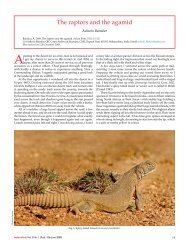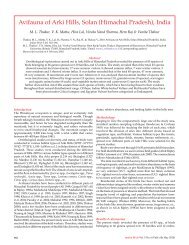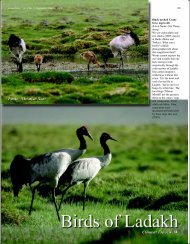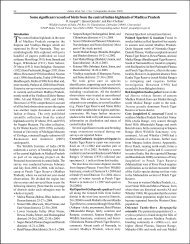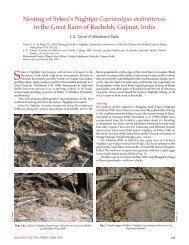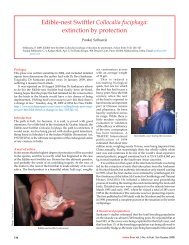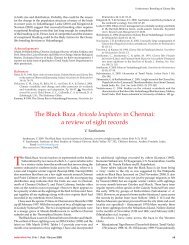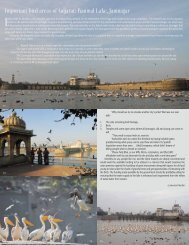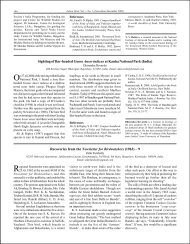Conservation of birds of the Andaman & Nicobar Islands - Indian Birds
Conservation of birds of the Andaman & Nicobar Islands - Indian Birds
Conservation of birds of the Andaman & Nicobar Islands - Indian Birds
- No tags were found...
You also want an ePaper? Increase the reach of your titles
YUMPU automatically turns print PDFs into web optimized ePapers that Google loves.
Vijayan: <strong>Andaman</strong> & <strong>Nicobar</strong> <strong>Islands</strong>(Vijayan et al. 2000) to <strong>the</strong> existing list for <strong>the</strong>se islands (Sankaran& Vijayan 1993) and during 2003–2004 we added three more(Vijayan et al. 2005; Mamannan & Vijayan 2009), while Yahya &Zarri (2002a) added ano<strong>the</strong>r, taking <strong>the</strong> list to 288. Studies in <strong>the</strong><strong>Nicobar</strong> <strong>Islands</strong> have revealed <strong>the</strong> status <strong>of</strong> several endemic <strong>birds</strong>and suggestions for developing a protected area network havebeen proposed (Sankaran 1995, 1997, 1998b). Many endemicswere rare and we could not ga<strong>the</strong>r enough data to determine <strong>the</strong>irstatus. Three species on <strong>the</strong> islands were found assessed to be <strong>of</strong>immediate conservation concern and were chosen for detailedstudies—<strong>Nicobar</strong> Megapode, Narcondam Hornbill, and <strong>Andaman</strong>Teal (Vijayan 1993).The avifauna <strong>of</strong> <strong>the</strong> <strong>Andaman</strong> <strong>Islands</strong> shows greater affinityto that <strong>of</strong> south-east Asia and mainland India, than with that <strong>of</strong><strong>Nicobar</strong> <strong>Islands</strong> (Vijayan et al. 2005). Endemic species preferredmoist forests and <strong>Andaman</strong> Cuckoo-Dove Macropygia rufipennis,<strong>Andaman</strong> Hawk-Owl Ninox a. affinis and <strong>Andaman</strong> Crake wererare; <strong>the</strong> last species being recorded for <strong>the</strong> first time from Northand Little <strong>Andaman</strong> (Vijayan et al. 2005). SACON’s landscapeecology study has generated biological richness maps, with areas<strong>of</strong> different grades, for each major island group; Little <strong>Andaman</strong>showed a third <strong>of</strong> its area as having very high priority, followedby South <strong>Andaman</strong> (Vijayan et al. 2005).<strong>Nicobar</strong> MegapodeThe <strong>Nicobar</strong> Megapode has two sub-species: M. n. nicobariensisinhabits <strong>the</strong> Nancowry group <strong>of</strong> islands north <strong>of</strong> SombreroChannel, mainly Nancowry, Teressa and Bomboka, and M .n.abbotti, <strong>the</strong> Great <strong>Nicobar</strong> group <strong>of</strong> islands, mainly Great <strong>Nicobar</strong>.The population <strong>of</strong> <strong>the</strong> former was estimated at 1,200–2,100 and<strong>of</strong> <strong>the</strong> latter between 3400 and 6000 (Sankaran 1995). Sankaran& Sivakumar (1999), Sivakumar (2000), and Vijayan et al. (2000)studied its ecology. This species is a primitive mound-nester <strong>of</strong><strong>the</strong> littoral forest (Ali & Ripley 1987), mainly restricting itselfto within 100 m <strong>of</strong> <strong>the</strong> beach. The populations showed declinesin many islands where <strong>the</strong> coastal forests were destroyed ordisturbed and <strong>the</strong> species is threatened (vulnerable) under IUCNcriteria (BirdLife International 2001, 2008). The present status, aftertsunami, reveals a decline <strong>of</strong> about 70%, as <strong>the</strong> littoral forest hasbeen heavily destroyed (Sankaran 2005; Sivakumar 2007).Narcondam HornbillThis species has a highly restricted range (6.82 km 2 ) on NarcondamIsland in North <strong>Andaman</strong>. Its population was estimated at 330–360 in 1998 (Sankaran 1998c), showing a decline from <strong>the</strong> 1972record <strong>of</strong> 400 (Hussain 1984). It is threatened (vulnerable) underIUCN category (BirdLife International 2008). Sankaran (1998c),and Vijayan et al. (2000) documented its altitudinal distribution,nests, and population structure . Breeding <strong>birds</strong> were over fouryears old and constituted around 46–53% <strong>of</strong> <strong>the</strong> population. Amajority (88%) <strong>of</strong> <strong>the</strong> nests was below 200 m altitude while <strong>the</strong>younger non-breeding <strong>birds</strong> occupied elevations >300 m. Thenests were located in holes on <strong>the</strong> trunk or broken branches <strong>of</strong>large trees. <strong>Birds</strong> fed on a wide variety <strong>of</strong> fruits and invertebratesand occasionally small reptiles.Ano<strong>the</strong>r short-term study was carried out between Januaryand March 2003 on roosting and nesting by Vivek & Vijayan(2003). Their population estimate was 320–340 <strong>birds</strong>, which wassimilar to that <strong>of</strong> <strong>the</strong> earlier study but differed from <strong>the</strong> 432 <strong>of</strong>Yahya & Zarri (2002b), . These <strong>birds</strong> used mature undisturbedforests with large trees for nesting and roosting. Additionalinformation was obtained on roosting and pre-nesting activities.A megapode on <strong>the</strong> banks <strong>of</strong> <strong>the</strong> Gala<strong>the</strong>a River at South Bay, Great <strong>Nicobar</strong> Island (2002).Photo: Pankaj Sekhsaria104 <strong>Indian</strong> <strong>Birds</strong> Vol. 5 No. 4 (Publ. 15th October 2009)
Vijayan: <strong>Andaman</strong> & <strong>Nicobar</strong> <strong>Islands</strong>Adult <strong>birds</strong> roosted in pairs on large trees at elevations <strong>of</strong>
Vijayan: <strong>Andaman</strong> & <strong>Nicobar</strong> <strong>Islands</strong>Although an ecological study <strong>of</strong> <strong>the</strong> <strong>Andaman</strong> Teal wasconducted for two years, evaluating its habitat requirements, anestimate <strong>of</strong> such available habitats and movement patterns needto be worked out immediately and site-specific action neededto save this species from extinction (Vijayan 2006; Vijayan etal. 2006). The ecology <strong>of</strong> <strong>the</strong> Narcondam Hornbill, althoughpartly studied during one breeding season, has yet to be studiedintensively (Sankaran 1998c; Vijayan et al. 2000; Vivek & Vijayan2003). The <strong>Andaman</strong> Crake has a low nesting success, and itsfledgling success could not be recorded. Its population is naturallyfragmented and <strong>the</strong>re has been a loss <strong>of</strong> <strong>the</strong> species from manylocalities due to habitat loss and degradation. Considering all<strong>the</strong>se factors, management regimes should ensure that adequateprotection is given to this species, especially during its breedingseason, and full protection <strong>of</strong> <strong>the</strong> crucial areas from any kind <strong>of</strong>human and related disturbances, especially in <strong>the</strong> larger islands(Vijayan & Ezhilarasi 2007). Some <strong>of</strong> <strong>the</strong> above areas are partlyor fully protected and many o<strong>the</strong>rs are near human settlements.Vijayan & Sankaran (2001) have already proposed <strong>the</strong> sou<strong>the</strong>rnpart <strong>of</strong> Rutland Island be declared an <strong>Andaman</strong> Teal Sanctuary.The habitat <strong>of</strong> this Crake in <strong>the</strong> localities without full protectionmay be declared as Sanctuaries or <strong>Conservation</strong> Areas, delineating<strong>the</strong> boundaries depending on <strong>the</strong> status <strong>of</strong> <strong>the</strong> land and feasibility.Islam & Rahmani (2004) have listed 19 sites in <strong>the</strong> <strong>Andaman</strong> and<strong>Nicobar</strong> <strong>Islands</strong> as Important Bird Areas and conservation actionsare needed for <strong>the</strong>se and o<strong>the</strong>r species-specific sites.Population <strong>of</strong> <strong>the</strong> Edible-nest Swiftlet was found to declinebecause <strong>of</strong> <strong>the</strong> unsustainable harvesting for trade (Sankaran1998a). Recent studies have shown that nests could be utilisedwithout much adverse effect on <strong>the</strong> population if protection isprovided and collected in a planned manner and also throughfarming as in many south Asian countries.Hunting or poaching occurs even in protected areas mostlybecause <strong>of</strong> <strong>the</strong> inadequate facilities with <strong>the</strong> Forest Departmentand lack <strong>of</strong> awareness in <strong>the</strong> local communities, which shouldbe addressed with all seriousness (Vijayan & Sankaran 2001;Vijayan et al. 2005, 2006). Suggestions for <strong>the</strong> conservation <strong>of</strong> <strong>the</strong>avifauna and biodiversity <strong>of</strong> <strong>the</strong>se islands, resulting from variousstudies, should be discussed and implemented to maintain <strong>the</strong>seecologically sensitive and still pristine areas <strong>of</strong> our country.AcknowledgementsRavi Sankaran and I undertook initial surveys with funding from SACONand <strong>the</strong> initiative <strong>of</strong> its former Director, V. S. Vijayan. The Edible-nestSwiftlet survey was carried out by Ravi Sankaran, supported by Traffic-India through WWF-India. The first major project was funded by <strong>the</strong>Man and Biosphere Reserve Programme <strong>of</strong> <strong>the</strong> Ministry <strong>of</strong> Environment& Forests, Government <strong>of</strong> India with <strong>the</strong> study <strong>of</strong> <strong>the</strong> <strong>Nicobar</strong> Megapodeby Ravi Sankaran and Sivakumar; Narcondam Hornbill by Ravi Sankaran;and <strong>Andaman</strong> Teal by V Murugan and myself. Ano<strong>the</strong>r major (longterm)project on <strong>the</strong> Edible-nest Swiftlet, executed by Ravi Sankaranand Shirish Manchi, has been supported by <strong>the</strong> Forest Department <strong>of</strong><strong>Andaman</strong> and <strong>Nicobar</strong> <strong>Islands</strong>. The project on <strong>the</strong> <strong>Andaman</strong> avifaunaand biodiversity characterisation was overseen by S. N. Prasad, M. A. RajaMamannan, Priti Kaushik, A. Giriraj, and myself, and was funded by <strong>the</strong>NBDB, Department <strong>of</strong> Biotechnology, Ministry <strong>of</strong> Science & Technology,Government <strong>of</strong> India. N Ezhilarasi and I conducted <strong>the</strong> study on <strong>the</strong><strong>Andaman</strong> Crake with financial assistance from <strong>the</strong> Ecosystem ResearchProgramme <strong>of</strong> <strong>the</strong> Ministry <strong>of</strong> Environment & Forests, Government<strong>of</strong> India. The above studies could be done successfully because <strong>of</strong> <strong>the</strong>sincerity and hard work <strong>of</strong> <strong>the</strong> research students under <strong>the</strong> guidance <strong>of</strong><strong>the</strong> scientists with <strong>the</strong> cooperation from <strong>the</strong> administrative staff and o<strong>the</strong>rstudents <strong>of</strong> SACON.These studies would not have been possible without <strong>the</strong> whole-heartedco-operation and assistance from <strong>the</strong> Forest Department <strong>of</strong> <strong>Andaman</strong> and<strong>Nicobar</strong> <strong>Islands</strong>. Officials <strong>of</strong> various o<strong>the</strong>r departments such as DistrictAdministration, Forest Development Corporation, Public Works, HarbourWorks, Tribal Welfare, Police, Navy, and Coast-guard were also helpful.Scientists from various institutions, namely Botanical Survey <strong>of</strong> India,Zoological Survey <strong>of</strong> India and Central Agricultural Research Institute,<strong>Andaman</strong> and <strong>Nicobar</strong> <strong>Islands</strong> Environmental Team, and many o<strong>the</strong>rshelped us during <strong>the</strong> study. We have benefited from <strong>the</strong> discussionsand communication with many o<strong>the</strong>r scientists within and outside <strong>the</strong>country. The support from many field assistants and <strong>the</strong> local communitiesthroughout our studies is gratefully remembered. My heartfelt thanks goto Aasheesh Pittie for taking <strong>the</strong> initiative <strong>of</strong> publishing a memorial issue<strong>of</strong> <strong>Indian</strong> <strong>Birds</strong> for Ravi Sankaran and for inviting an article from me.ReferencesAli, S. & Ripley, S. D., 1987. Compact handbook <strong>of</strong> <strong>the</strong> <strong>birds</strong> <strong>of</strong> India and Pakistantoge<strong>the</strong>r with those <strong>of</strong> Bangladesh, Nepal, Bhutan and Sri Lanka. 2nd ed.Delhi: Oxford University Press.Andrews, H. V., Jayaraj, R. S. C., & Mundoli, S., 2006. State <strong>of</strong> environment2005, <strong>Andaman</strong> and <strong>Nicobar</strong> <strong>Islands</strong>. Hyderabad, India: UniversitiesPress (India) Pvt. Ltd.Anon. 2001. Threatened waterfowl species and sub-species. ThreatenedWaterfowl Specialist Group News Bulletin 13: 2–4.Anon. 2008. <strong>Conservation</strong> <strong>of</strong> <strong>the</strong> Edible-nest Swiftlet Collocalia fuciphagain <strong>the</strong> <strong>Andaman</strong> and <strong>Nicobar</strong> <strong>Islands</strong>. Pp. 31. Project Report.Coimbatore, India: Salim Ali Centre for Ornithology & NaturalHistory; Forest Department <strong>of</strong> <strong>Andaman</strong> and <strong>Nicobar</strong> <strong>Islands</strong>.Bibby, C., Burgess, N. D., & Hill, D. A., 1992. Bird census techniques. London,U.K.: Academic Press.BirdLife International 2001. Threatened <strong>birds</strong> <strong>of</strong> <strong>the</strong> world. Barcelona &Cambridge: Lynx Editions & BirdLife International.BirdLife International 2008. The BirdLife checklist <strong>of</strong> <strong>the</strong> <strong>birds</strong> <strong>of</strong> <strong>the</strong>world, with conservation status and Taxonomic sources. Version1. URL: http://www.birdlife.org/datazone/species /downloads/BirdLife_Checklist_Version_1.zip [.xls zipped 1MB].Brooks, T., Pimm, S. L., & Collar, N. J., 1997. Deforestation predicts <strong>the</strong>number <strong>of</strong> threatened <strong>birds</strong> in insular Sou<strong>the</strong>ast Asia. <strong>Conservation</strong>Biology 11: 382–394.Castellatta, M., Sodhi, N. S., & Subraj, R. 2000. Heavy extinctions <strong>of</strong> forestavifauna in Singapore: lessons for biodiversity conservation in sou<strong>the</strong>asternAsia. <strong>Conservation</strong> Biology 14 (6): 1870–1880.Davidar, P., Devi, S. M., Yoganand, T. R. K., & Ganesh, T., 1995. Reservesize and implications for <strong>the</strong> conservation <strong>of</strong> biodiversity in <strong>the</strong><strong>Andaman</strong> <strong>Islands</strong>. In: Boyle, T. J. B., & Boontawee, B., (eds.) Measuringand monitoring biodiversity in tropical and temperate forests. Indonesia:CIFOR.Davidar, P., Yoganand, T. R. K., Ganesh, T., & Joshi, N., 1996. An assessment<strong>of</strong> common and rare forest bird species <strong>of</strong> <strong>the</strong> <strong>Andaman</strong> <strong>Islands</strong>.Forktail 12: 135–142.Ezhilarasi, N., 2009. Status and ecology <strong>of</strong> <strong>the</strong> <strong>Andaman</strong> Crake. PhD <strong>the</strong>sis.Coimbatore, India: Bharathiar University.FSI. 1999. Status report on <strong>the</strong> forests <strong>of</strong> India. Dehradun, India: ForestSurvey <strong>of</strong> India.FSI. 2005. Status report on <strong>the</strong> forests <strong>of</strong> India. Dehradun, India: ForestSurvey <strong>of</strong> India.Green, A. J., 1992. Wildfowl at risk, 1992. Wildfowl 43: 160–184.Green, A. J. 1996. Assessment <strong>of</strong> which Anatidae taxa qualify for globallythreatened status. Gibier Faune Sauvage, Game Wildl. 13 (1): 777–798.Hussain, S. A., 1984. Some aspects <strong>of</strong> <strong>the</strong> biology and ecology <strong>of</strong>Narcondam Hornbill (Rhyticeros narcondami). J. Bombay Nat. Hist.Soc. 81 (1): 1–17.IIRS. 2003. Biodiversity characterization at landscape level in <strong>Andaman</strong> &<strong>Nicobar</strong> <strong>Islands</strong> using satellite remote sensing and geographic informationsystem. Dehradun, India: Department <strong>of</strong> biotechnology, Government<strong>of</strong> India & Department <strong>of</strong> Space, Government <strong>of</strong> India.Islam, M. Z., & Rahmani, A. R., 2004. Important bird areas in India: prioritysites for conservation. Mumbai, India: IBCN & BNHS.Jayaraj, R. S. C., & Andrews, H. V., (eds). 2005. <strong>Andaman</strong> & <strong>Nicobar</strong> <strong>Islands</strong>Union Territory biodiversity strategy and action plan. Pp. 142. India:Prepared under <strong>the</strong> National Biodiversity Strategy and Action Plan-India, ANET/ GOI-UNDP/A &N D E & F. Universities Press.Mamannan, M. A. R., & Vijayan, L., 2009. Three new bird records from106 <strong>Indian</strong> <strong>Birds</strong> Vol. 5 No. 4 (Publ. 15th October 2009)



